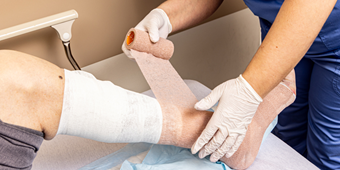‘Mommy’s Thumb’ a Common Condition Among New Parents

Find Your Perfect Match
Answer a few questions and we'll provide you with a list of primary care providers that best fit your needs.
Wrist tendinitis may be finding its place among sleep deprivation, diaper duty, and midnight feedings as a rite of passage into parenthood.
Wrist tendinitis is a common overuse condition that new parents, especially mothers, experience. The painful condition – which occurs when the tendons that run across the wrist to attach to the thumb become inflamed – is often referred to as “mommy’s thumb,” says hand surgeon Beth Berrettoni, MD.
Tendons are cords that come off a muscle and cross a joint and attach to bone. When a muscle contracts, it shortens and pulls on the cord-like tendon, which then causes a part of the body to move. The tendons that cross the wrist cause the wrist or one of the fingers or thumb to move. Tendonitis is when a tendon becomes inflamed, which means it is irritated, swollen and sore, she says.
“Mommy’s thumb” is an informal term for the tendinitis called De Quervain’s tendinitis. De Quervain’s tendons are the ones specifically move the thumb and that cross over the wrist on the thumb side. Parents use these tendons when placing their hands under a baby’s armpits to pick the child up, which can cause pain to be felt near the thumb or around the wrist.
“Wrist tendinitis is often activity-related, and I have seen quite a few new mothers come in with this issue, and some new fathers and grandparents also,” says Dr. Berrettoni. “Mothers develop wrist tendinitis when they are repeatedly picking up their babies by placing their hands under the baby’s armpits and lifting.”
What to Do When it’s Wrist Tendonitis
If you think you may have wrist tendinitis:
Assess your symptoms. Wrist tendinitis is characterized by the following symptoms: Pain on the back of the thumb when a fist is made, something is grabbed, or when the wrist is turned; swelling of the wrist; and stiffness when moving the thumb or wrist.
Treat the symptoms. Ice your wrist for 20 minutes of every hour while awake. Be careful not to apply ice directly to the skin. For pain, use ibuprofen (Advil or Motrin), naproxen (Aleve or Naprosyn), or acetaminophen (Tylenol). Nursing mothers should first consult with their physician before taking any of these medications.
Rest and stabilize. Rest the affected area by stabilizing it with a splint that holds the thumb still, called a thumb spica splint. Keep it stable for at least one week. Once the wrist is able to move without pain, it is important to do light stretching that can help strengthen the wrist again.
Seek professional advice. Seek professional advice from a doctor if the pain does not improve or becomes worse, if the wrist becomes stiff, if there is increasing numbness or tingling in the wrist and fingers, or if they turn white or blue.
Specialists like Dr. Berrettoni are able to do an exam and assess a patient’s individual needs and decide what type of treatment is best among the options of splinting, therapy, cortisone injections, or surgery. Treatment can be tailored for new mothers, including those who are nursing. Braces can be made by a hand therapist to fit a mother according to how her hand is positioned when she picks up her baby. A cortisone injection may be tried if the mother is not nursing or in instances where the mother stores milk to avoid the time period around the cortisone injection, or for fathers and grandparents.
“Typically as the baby grows, the way you hold the baby changes,” Dr. Berrettoni says. “So for a lot of new parents, their problem may resolve over time.”
Find Your Perfect Match
Answer a few questions and we'll provide you with a list of primary care providers that best fit your needs.
Source: Beth Berrettoni, MD, Hand and Reconstructive Surgeons and Associates; National Institutes of Health





